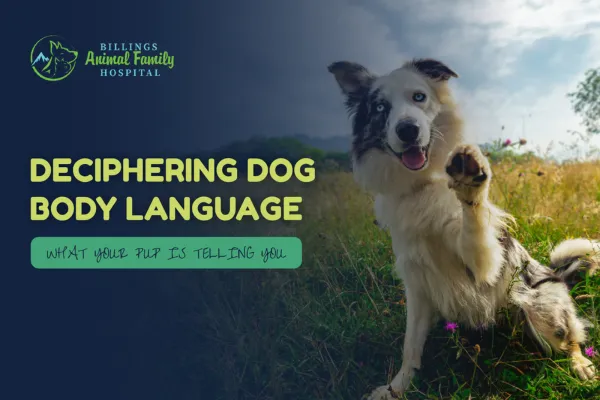
Deciphering Dog Body Language: Billings Animal Family Hospital
Deciphering Dog Body Language: What Your Pup Is Telling You
What does it mean when your dog tilts their head, tucks their tail, or perks up their ears? Dogs may not speak our words, but they are constantly communicating through posture, movement, and expression. Learning to read dog body language helps you understand their needs, strengthens your bond, and keeps both of you safe.
At Billings Animal Family Hospital, we see every day how better communication leads to healthier, happier pets. Let's break down the cues that reveal what your pup is really telling you.
What You'll Find In This Post . . .
Deciphering Dog Body Language: What Your Pup Is Telling You
Understanding why dog body language matters
A relaxed dog demonstrates joy and happiness
Anxious and fearful dogs exhibit signs through tail movement and posture
Interest and focus are revealed through an alert posture
Aggressive dogs communicate through warning cues
Calming signals show when a dog wants to avoid conflict
Ears tell their own story when you read them carefully
Building trust comes from observing and responding with care
2. How to learn dog body language?
3. Do dogs communicate through body language?
4. What is a dog's body language when playing?
5. Does panting always mean a dog is hot?
Bringing it all together: Deciphering canine body language
Understanding why dog body language matters
Dogs use their whole body to communicate; ears, eyes, tails, and posture all work together to express emotion. When you learn to interpret these cues, you can quickly tell whether your dog feels relaxed, excited, anxious, or threatened.
Misreading signals can cause unnecessary stress, confusion, or even conflict, especially around other dogs. By understanding body language, you can respond in a way that keeps your pup comfortable and builds trust.

A relaxed dog demonstrates joy and happiness
A happy, relaxed dog usually makes their mood easy to spot. Their body looks loose, their eyes are soft, and they often move with a bouncy, playful rhythm.
Signs of joy and affection may include:
A relaxed body posture with a wagging tail
A playful bow, with front legs stretched forward
Gentle nudges or an affectionate lick for attention
These are clear examples of a happy dog showing contentment. If your dog likes what's happening, they'll display these cues without hesitation.

Anxious and fearful dogs exhibit signs through tail movement and posture
Not all signals are positive. An anxious or fearful dog often communicates stress with their ears and tail. You may notice pinned ears, tail tucked tightly, or a lowered head, avoiding eye contact. Some dogs exhibit the "whale eye" phenomenon, where the whites of their eyes are visible, or they may yawn repeatedly when not tired.
These signals usually mean the dog is uncomfortable. Respecting their space, staying calm, and avoiding forced interaction helps prevent escalation. For more insight into stress behaviors, the ASPCA offers guidance on how your dog is communicating discomfort.

Interest and focus are revealed through an alert posture
Sometimes you’ll see your dog suddenly stiffen, perk up their ears, and hold their tail straight. This usually signals curiosity or focus. Their mouth may close, their gaze may lock onto something, and their body may lean forward in anticipation.
This type of dog body language means your pup is processing what's happening, whether it's a squirrel darting by, another dog passing, a new sound, or a toy they want. Allow them to observe, but be cautious. Interest can quickly shift to chasing, barking, or other strong reactions.

Aggressive dogs communicate through warning cues
Aggression is a form of communication, too, and knowing the early signs can prevent dangerous situations.
Aggression cues often show through a stiff or tense body posture, such as:
Raised hackles along the back
Lips curled back to expose teeth
An intense, unblinking stare
Growling, barking, or sudden lunging
An aggressive response does not necessarily mean your pet is bad; it often means your dog could be fearful, protective, or simply overwhelmed. Professional help, such as dog training and behavioral counseling, can make a big difference in these cases.

Calming signals show when a dog wants to avoid conflict
Dogs often use calming signals to prevent tension from escalating. A slow wag, a turned head, or lip-licking in a stressful situation are common ways they say, "I don't want trouble." Repeated yawns when not sleepy can mean the same thing.
When your dog appears nervous and offers calming signals, the best response is to give them space and show patience. Respecting these cues reassures them that they are safe and heard.

Ears tell their own story when you read them carefully
Your dog's "ear language" is one of the clearest ways to gauge their mood:
Forward ears often indicate interest or alertness.
Sideways or relaxed ears suggest your dog is comfortable.
Pinned ears usually signal fear, anxiety, or submission.
One ear forward, one ear back can show uncertainty or curiosity.
Ears moving constantly may indicate excitement or heightened attention.
Ears flat against the head with tense muscles often reflect stress or aggression.
The key to truly understanding your dog's ear language is to look at ear position in combination with tail movement, posture, and facial expressions. Together, these cues paint a complete picture of what your dog is feeling.

Building trust comes from observing and responding with care
Understanding how dogs communicate allows you to build a stronger bond based on trust.
Reacting calmly to signs of stress
Respecting warnings before they escalate
Rewarding playful invitations and positive behavior
You create a safe environment where your dog feels understood. At Billings Animal Family Hospital, we help pet parents interpret canine signals and respond in ways that support long-term well-being. From wellness care to guidance on training, our team is here for you and your furry family member.

Frequently asked questions
1. Do dogs use body language?
Yes! A dog often communicates through gestures like tail wags, ear positions, and posture. Your dog may use these cues to show excitement, comfort, or stress.
2. How to learn dog body language?
Pay attention to your dog’s movements, tail wags, and play bows. Over time, you’ll notice patterns that reveal how your dog is trying to express themselves.
3. Do dogs communicate through body language?
Absolutely. A dog is trying to tell you how they feel through posture, tail wags, facial expressions, and ear positions. Reading these signals helps you understand your dog better.
4. What is a dog's body language when playing?
Look for play bows, wagging tails, and relaxed postures. Your dog may alternate between playful gestures and gentle nips to invite interaction.
5. Does panting always mean a dog is hot?
Not always. A dog is trying to cool down, but panting can also signal excitement, stress, or anxiety. Context and other body cues help you understand why your dog is panting.

Bringing it all together: Deciphering canine body language
Every tail wag, ear flick, or posture shift tells a story. By learning to read dog body language, you can prevent miscommunication, avoid unnecessary stress, and build a relationship rooted in trust.
Read our articles on dog behavior to better understand your furry friend:
For personalized guidance and compassionate care tailored to your pup’s needs, contact us today. Our team is here to help you better understand your dog and strengthen the bond you share.



